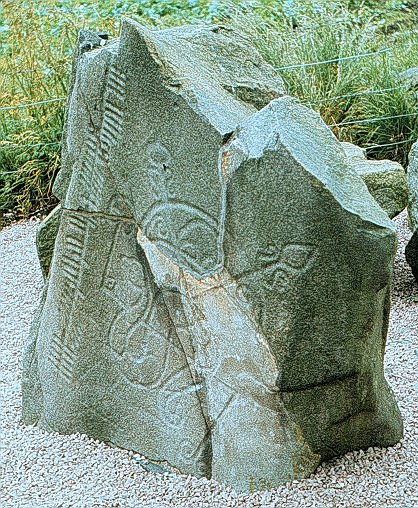I don't think so. The Picts were a distinct people living in modern day Scotland, and were joined in the first half of the first millennium AD by Celtic Irish. The name "Picts" means "the Painted Ones" and it was given to them by the Romans. It was the Irish culture which came to be most prevalent in Scotland.
I don't think that there was ever any debate as to whether the Picts were Gaels. They were not. If they were, why would Columba have needed an interpreter for his mission to Scotland? The question was whether the Picts were Celtic at all. More specifically, the question was why popular culture seems to labor under the belief that the Picts were not Celts, when most evidence seems to indicate that they were.
I'm glad that this topic was revived, though. I've been thinking lately about the Pictish language and why the Romans claimed it to be totally distinct from the British language, despite its almost certainly Brythonic nature. I'm wondering if perhaps Pictish had a similar relationship to Irish as English does to French. English is an essentially West Germanic language, and that accounts for the language's core lexicon and grammar. However, French has a
huge influence on English, accounting for a very large amount of its vocabulary. What if Pictish, whilst being an essentially Brythonic, P-Celtic language, had a substantial Irish substrate? This would explain many things. The supposed lack of Pictish and Brythonic mutual intelligibility would make sense, as would the occurrence of "maqq" and "meqq" - mentioned earlier by Taranis - on Pictish inscriptions.
This Irish substrate can be explained if we make a few assumptions about the nature of the Gaels' and the Picts' relationship. Now, I freely admit that what I'm about to say is pure conjecture, but it makes sense to me. I am no expert on this subject. If anyone sees any holes in my argument, by all means, please point them out. I believe that the Irish and the Picts may have had much closer relations than previously thought. We know that the Gaels and the Picts were aware of each other long before the founding of the Dál Riata. There existed a subset of the Irish population called the "Cruithne", centered in Ulster. This most likely derived from the same word as P-Celtic "Priteni" or "Britanni". "Cruithne" is also the word that the Irish used to refer to the Picts. Now, the Annalists don't really describe the Cruithne as being any different from the other Irish clans and groups as far as I know. However, simply by virtue of their name and the fact that the Annalists also refer to the Picts as "Cruithne", I believe that the Cruithne were likely Picts that crossed the Irish Sea and settled in Ulster. This supposed settlement would have likely occurred when Pictish and Brythonic was still mutually intelligible, or even before there existed a distinction between Pict and Brython. Hence the Irish would have still referred to them as Brythons, or "Cruithne" in their own tongue. This distinction would have survived long after the Pictish settlers adopted the Irish language, and perhaps the memory of the Cruithne's origin accounts for why the Annalists referred to their Pictish contemporaries as Cruithne. Again, conjecture. It makes sense to me however.
Now, if the Picts and the Irish had such a close relationship that some of the Picts settled in Ireland, then they most likely traded and interacted with each other often. And if Pictish families could settle in Ireland, why would Irish families not do the same in Scotland/Pictland, albeit in small numbers? Perhaps this "special relationship" between the Irish and the Picts is what gave birth to a distinct Pictish language, a tongue with a Brythonic superstrate and an Irish substrate influential enough to render it maybe not incomprehensible to Brythons, but nonetheless distinct from Brythonic. The Romans probably weren't familiar enough with Brythonic in the first place to recognize the similarities in Pictish, merely hearing the Irish vocabulary and dismissing it as a totally unrelated language.
The relationship between the Irish and the Picts likely would have intensified after the Roman occupation of Britain. The Picts would have been cut off from interaction and trade with their kinsmen further south, leaving themselves and the Gaels as the only unconquered Insular Celts. This would have further developed the Pictish language, and might have laid the groundwork for the Gaelic/Pictish merge after Irish/Pictish relations took a more militaristic turn.
This relies on a lot of assumptions, and doesn't explain the apparently nonsensical Pictish inscriptions. I would also think that Irish and Pictish material culture would be more similar than they are, if the Gaels and the Picts were as close as I'm suggesting they might have been. I'm unaware of any Irish knotwork in pre-Dál Riata Scotland, or of any Pictish Beasts in Ireland. The Picts were most likely centered in Northeast Scotland, far from the Irish Sea. And of course, this is unsupported by the Annals as far as I'm aware. Nonetheless, I feel that this would explain many things about the Picts, and might help us in learning more about the language. What do you folks think?
Also, on a somewhat related note, this line of thinking makes me wonder if there exists a Pictish/Brythonic substrate in Ulster Irish. Would anyone here, by any chance, happen to know this?




